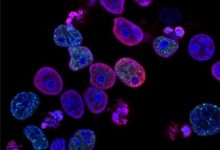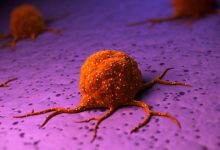
Ovarian cancer goes hidden until it has spread within the pelvis and stomach. Ovarian cancer gets spread to the omentum in nearly 80 percent of the women before it was diagnosed. Within the omentum, cancer grows even faster
The lesser known ‘ Omentum’
The omentum is one of the human body’s largest organs, but also arguably one of its least familiar – to scientists as well as the rest of us. The omentum is a curtain of fatty tissue that hangs down from our stomach and liver and wraps around the intestines.
What’s New
A new research led by the researchers of the University of Chicago Medicine explains how quickly ovarian cancer cells take the next steps to spread to other parts of the body. After penetrating the omentum, these cancer cells eat up the fat cells there, after that tumor recruited cancer-associated fibroblasts (CAFs).
These CAFs generate energy sources for the tumor by increasing blood flow to the tumor so that cancer cells can multiply and spread to another part of the body.
In their current study, the researchers used a technique called quantitative phosphoproteomics to characterize the reciprocal signaling between human ovarian cancer cells and the CAFs that hasten the spread of abdominal cancers.
What did they do in their study
In the laboratory, researchers grew human ovarian cancer cells together with CAFs in the lab and analyzed key components of their cellular crosstalk. This allowed the researchers to examine the role of glycogen in the metabolism and rapid spread of ovarian cancers.
“This is the first time that the role of glycogen in cancer metastasis has been thoroughly investigated,” said the study’s senior author, Ernst Lengyel, MD, PhD, the Arthur L. and Lee G. Herbst Professor and Chairman of Obstetrics and Gynecology at the University of Chicago.
“No systematic study of the signaling pathways initiated by human cancer cells and cancer-associated fibroblasts has been performed,” he added. “We think this could have significant clinical implications.”
Cascade of events that helps in disease spread
Fibroblast-derived chemical signals help mobilize glycogen in cancer cells, which is then metabolized into glucose/sugar. This is used by cancer cells as a source of energy, helping those cells invade other tissues. It also boosts tumor aggressiveness, enhancing proliferation, invasion, and metastasis.
Blocking the ovarian cancer spread
With this study in mind, researchers can inhibit the cancer spread by inhibiting any step in the process. They can block glycogen mobilization in cancer cells by interfering with enzymes mobilizing glycogen, or inhibiting signaling pathways that prevent the glycogen mobilization stimulated by CAFs, “might be a therapeutic strategy for the reduction of tumor dissemination in abdominally metastasizing cancers after optimal tumor reduction.”






